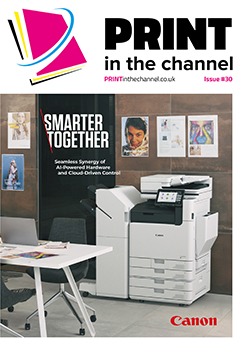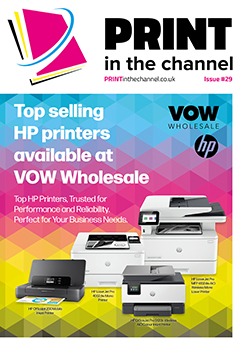Trading up
Sustainability throughout a business is increasingly key – so finding sustainable ways to dispose of devices such as photocopiers is important, and Trade Copiers does just that. But behind the successful business is a clever process that ensures everything is traceable and means Trade Copiers is set for a promising future.
For many businesses, sustainability is increasingly becoming key – not just in how they conduct their business, but throughout their supply chain and product lifecycle – which can be demonstrated to customers of businesses they are working with. No longer can a fleet of photocopiers be replaced and just sent to landfill, as in years past, now they need ensure they have a life after their first deployment. This is where Trade Copiers comes in.
Trade Copiers, which is based in Penrith, takes used photocopiers, wipes their data, prepares them and then sells them on, be it to the UK or overseas.
“We think that every device we export is one machine saved from landfill,” says Mark Gemmell, Trade Copiers’ head of sales and operations. “We consider ourselves an extremely sustainable business. A lot of the devices would end up in the ground or being reused potentially as a raw material. By finding a second life for it, it is doing the right thing environmentally, which is important.
“Businesses want to see that sustainability is in your overall business model and business culture. Because of our services, we’re able to offer clients an opportunity to do that. If someone’s looking to obtain a specific ISO or an industry award, sustainability is key and our entire business model provides that service for a lot of clients in areas that they’re just unable to fulfill themselves.”
It is a business that has boomed in recent years. During COVID, and the disruption that bought to the supply chain, it drove the demand for used copiers up, along with prices. “It made for a really competitive and exciting market for used products,” he says. “That bubble was never going to last and although we had a record-breaking year last year, the bubble has somewhat burst as the supply of new devices has become more sustainable and consistent. So while demand for used devices isn’t quite as high as it was, we’re still finding the market extremely buoyant. But rather than customers fighting over the stock that we have, our salespeople have had to go back into selling mode and ensure that we are offering all our inventory to the right people.
“On average, every copier that arrives stays in stock for less than 30 days. We’ve got two huge facilities in Penrith, but they’re constantly full, so we have an obsession about age stock and stock turn. If we’ve got a copier that’s been in stock for longer than average, it’s being reviewed daily because for every day it stays effectively it’s costing us money.”
Export market
About 95% of what Trade Copiers sells goes to export, says Mark. “We only sell the very cream of the crop back into the UK and we still see strong demand for that product despite the availability of new devices and the willingness of people to now do deals.
“But we know that the demand is there for copiers because of the amount we’re buying. We’re still buying 40-45,000 devices a year and most of them are from dealer groups that have been in end user sites. As long as that number remains buoyant, we know that people are having their copiers replaced. So that would give us an indication that it’s a very strong market.”
Trade Copiers’ process is simple. They generally collect used devices from a dealer – perhaps that has completed a rollout of new copiers to a customer – and bring them back to their facility. The copiers are in batches, with a barcode. A tester will then scan the barcode, which loads the information onto Trade Copiers’ bespoke system.
The copiers will then have any physical GDPR data, labels etc taken off, before they go through a robust data erasure process.
Bespoke system
“We go through secure data destruction,” Mark says. “We offer various levels of that, depending on the client’s requirements. Our system, the CAS – Copier Analysis System – which was built in-house from scratch, is clever: the tester will scan the barcode that the device came in on and that client’s preferences are saved on it. For example, it may say they want a certain level of data security, and the device can’t then be resold into the UK.
“The preferences are pre-populated, so we know specific information, for example that it can’t go back into the UK. The data gets wiped, the machine gets fully tested, we fill out key measurements from the device and then add it onto our online stock system. It’s then given a unique number, so it goes from a batch number to an individual number, it’s wrapped and then added to our stock.
“Then the sales teams can then see that device in stock. So when they’re building an order, whether it’s one device for a company or it’s 10 containers for an exporter, they can then allocate that device depending on the requirements of the customer. Each device has a passport, if you like, so we can see when it was bought, who bought it, how much they paid for it, what the customer’s requirements were, when the data was wiped, who wiped it, what happened to the hard drive, how long it was in stock, how much it was sold for, who it was sold to, when it was shipped, what container ship it was on and what date it landed in whatever country it was going to.
“That is really attractive to our clients because we all have an ever-increasing environmental responsibility and this allows them to know that each device, from a data security point of view and also an environmental responsibility point of view, is going where we say it is.
“Then if any of our clients ring me and ask for a serial number of photocopier from three years ago and what happened to it, I can tell them exactly what happened to it with a few clicks of a mouse. That makes us very different to our competitors because it breeds trust, it’s fully transparent. Every machine goes through the same process, and it allows us to report back with integrity.
“While we spend a lot of time putting information into our system, the value of the intelligence it provides us at the back end far outweighs that. And that’s why we’re so meticulous with everything that goes in. Every inquiry into the business, whether it’s a purchase or a sale, is logged against a customer profile, their desired models, their desired pricing. Because when we run a report, we can then see what driving models are. So even if someone doesn’t conclude a deal, their requirements are still logged so we can look at trends of product and price.”
Trusting to perform
Indeed, Mark is fastidious about the data logging, and expects all team members to be. While he says he is generally relaxed and pragmatic in his leadership style, he does insist that data is logged correctly.
“It’s the human element where the process can potentially fall down,” he says. “The integrity of the data is compromised if we’ve missed an inquiry that’s not taken into consideration.”
This isn’t just about sales – it is about those enquiries that don’t lead to a sale too. “In a position of leadership, you can only influence the people that aren’t buying or aren’t selling,” Mark says. “Although I love to see business getting done, I’m not that interested in the computer system showing me what deals have been concluded every day. I’d rather look at the people that we haven’t transacted with because I can get involved in those and I might be able to make an impact there. It’s people trusting that they can put 10 inquiries on, but no deals that day, and are not going to get a telling off for it, because it’s important that we understand why those people didn’t make a deal with us, so we can try and influence it more positively next time.
“If you have a culture of fear, then people will be reluctant to share that with you. The system only works if the people are in the right mindset and the right culture exists. We have that now, but it took several months to get us there.
“It’s about celebrating success and trusting people to perform to an exceptional standard. And our team has done that for several years now. And we can only do that by breeding confident and empowered people and trusting them to use their own intellect to go out and hit objectives. Now, they have very clear objectives, and the level of performance must be agreed with everyone. But once you have a target and then departmental targets and individual targets, if people know exactly what’s expected of them, they take responsibility for that and then they don’t need a manager constantly badgering them to perform because they’re empowered to achieve on their own with people in senior positions providing guidance and encouragement rather than policing performance.”
Reliability
Another key to Trade Copiers’ success is reliability. “It’s about telling a customer that if you’re going to be at their warehouse at 9am on a Tuesday morning with two artics to collect the stock, you make sure that you’re there at the date and time promised. Pace is an issue for most people and because we have a very large fleet of HGVs, we’re able to move resources to ensure that our customers can rely on us.
“If you let someone down, it spreads like wildfire. We’ve got a lot of big clients that are good ambassadors for our company that share that they work with us because we’ve built up these great relationships. We don’t actively market for new customers, a lot of it is built on reputation and word of mouth.”
Future
After the success of recent years, Mark says the focus for Trade Copiers is on consolidating their growth and continuing to grow organically – unless a strategic opportunity presented itself. “The biggest thing we’ve done in the past few years is increase market share,” he says. “And to do that, we’ve had to manage our reputation and make sure that our service is as good as we say it is.
“The plan for the next 12 months will be to refine the growth that we’ve had. We want to make sure that our level of service is maintained after the growth that we’ve had, and then I will probably sit down round the table again with all the internal stakeholders and build the next strategy. Because growth is two steps, you grow, then you refine, you grow, then you refine. If you grow, there’s no guarantee that the process that was working today will still work tomorrow because with growth comes new challenges. We’ll take the next 12 months to refine our processes and then we’ll go for another growth spike, if appropriate.”










